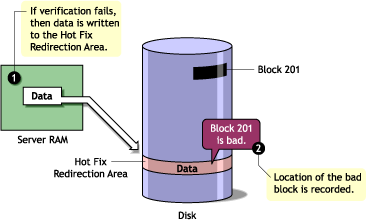Hot Fix

Due to the constant reading and writing of data to disk, some disk storage blocks lose their capacity to store data. NetWare uses Hot Fix to prevent data being written to unreliable blocks.
The Hot Fix feature redirects the original block of data (still in memory) to the Hot Fix Redirection Area of the NetWare partition. Once the operating system records the address of the defective block in a section of the partition area, the server will not attempt to store data in the defective block.
Hot Fix redirection can occur during a write request, a read request, or a read-after-write verification.
If the disk is mirrored, the system retrieves the data from the mirrored disk and redirects the data on the primary disk. If the disk isn't mirrored, the data is lost, and the block is marked as bad.
By default, 2% of a disk's space is set aside as the Hot Fix Redirection Area. You can increase or decrease this amount when you create a partition.
If Hot Fix is enabled, it is always active unless the disk fails or the redirection area is full. You can view Hot Fix activity in MONITOR by selecting Storage Devices and then a Hot Fix partition.
Figure 8
Hot Fix
You can specify no Hot Fix Redirection Area when you create disk partitions. Having no Hot Fix Redirection Area saves partition space. Eliminating the Hot Fix Redirection Area might be recommended for large (Redundant Array of Inexpensive Devices (RAID) systems that provide their own means of fault tolerance.
However, if Hot Fix is not enabled, the partition will not have the fault tolerance. Data on corrupted sectors of the disk will not be redirected to the Hot Fix Redirection Area.
For instructions on how to specify no Hot Fix redirection area, see Creating a Partition in the Novell Storage Services Administration Guide.